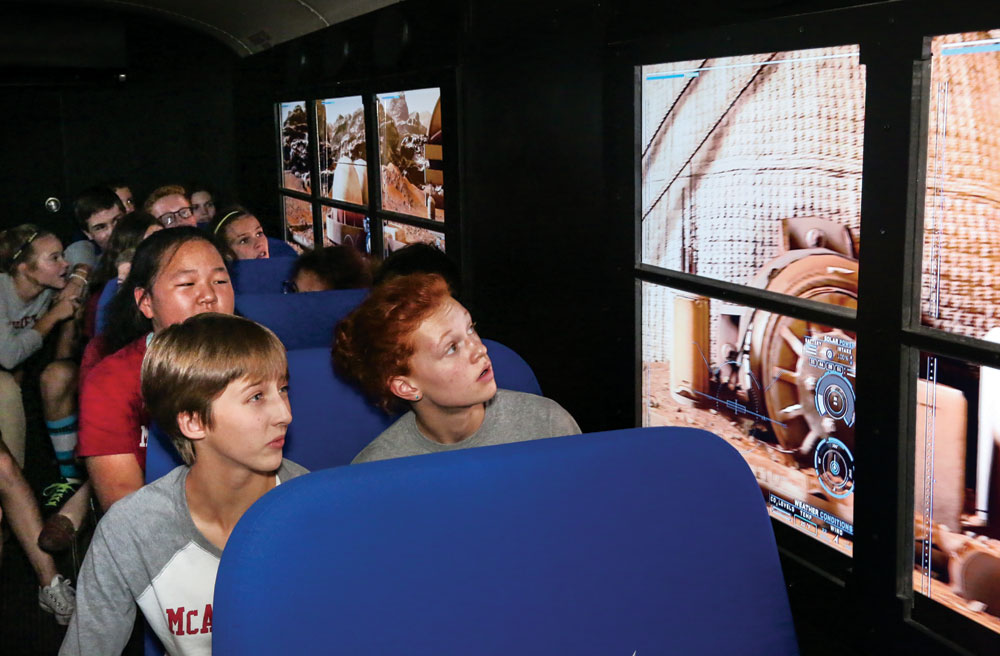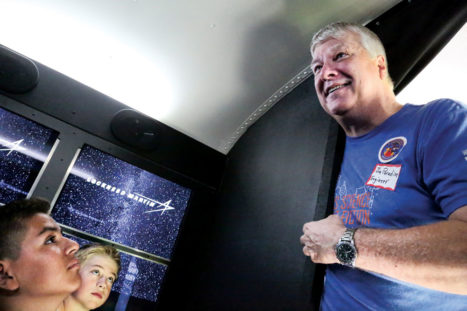
Students on the Lockheed bus ride see actual NASA images of the Mars surface and a simulated base camp that Lockheed expects to build on Mars. GPS programming in the video simulates turns and stops the bus actually makes during the 8-minute ride.
Middle school students fill the seats of what could be an ordinary school bus — but as it starts up, the darkened windows become a continuous video screen with images of the Mars landscape passing by. A computerized voice offers a steady stream of information: “Radiation levels—normal. Ground speed 30 meters per hour. Warning, considerable dust expected. Solar power generation 75% and falling. Switching to battery power. Temperature negative 96 degrees Fahrenheit.”

Lockheed engineer Jim Paradise introduces the Mars rover experience.
Visibility of the Mars landscape deteriorates during the dust storm. As the bus slows and stops—the scenes in the video slow and stop. The bus turns left and the images in the video track with the turn.
Lockheed Martin created this virtual reality vehicle to replicate the experience of traveling 200 square miles on the Martian surface and seeing what the base camp might look like. In all likelihood, a middle school student today will be one of the first human travelers to Mars in the mid-2030s—and Lockheed created this Mars rover simulation to inspire middle school students to pursue that goal.

Engineers from Lockheed Martin show students a replica Orion spacecraft and talk about their work on a manned mission to Mars in the 2030s.
Through a partnership with Denver Public Schools, Lockheed brought their “Mars rover” to McAuliffe Middle School where over 400 students experienced the simulated ride in early September. Lockheed engineers volunteered their time to talk to students and encourage them to take STEM courses (science, technology, engineering, math) and consider a career working on the Mars mission.
Engineer Jim Paradise says not enough engineers are graduating to fill the need and Lockheed Martin is bringing in engineers from other countries. “Half of our engineers are baby boomers and the mass exodus of baby boomers is beginning. There’s a huge shortage looming unless we can pump up that pipeline.
“When the dot com boom happened, a big chunk of kids went that way instead of engineering school—and engineering school enrollment went down for about a ten-year period,” says Paradise. Engineering enrollment has started increasing again, he says, but not enough to fill the need.
After the rover experience, students agreed it got their attention. Jill Vanderport says, “Before this I never thought about going to space.”
Maddie Carson-Cotton added, “I like to do experiences rather than build things. Staying up there for two years you’d really get a good feel for what Mars is like—exploring what people haven’t explored yet—it would be pretty worth it.”
Ben Kaufman says he would like to be on the engineering side—building but not going into space. “Personally I don’t think I’d risk my life and I wouldn’t like to be trapped in a small capsule for nine months out.”

McAuliffe eighth grade students line up for a virtual reality experience of a Mars rover in a school bus created by Lockheed Martin.
But Devon Rutledge says he’s all in for such a mission. “I’d like to be an on-board engineer because it sounds like on the Mars mission, no matter how many extra precautions they have, something is going to go wrong, and I’d be the person who would fix that on board so the mission wouldn’t fail. I feel like we’d still have communication with home, and I’m not all that social a person so it doesn’t really matter.”
More about Lockheed Martin’s mission to Mars and their efforts to interest young people in the project can be found at LockheedMartin.com/GenerationBeyond.




0 Comments